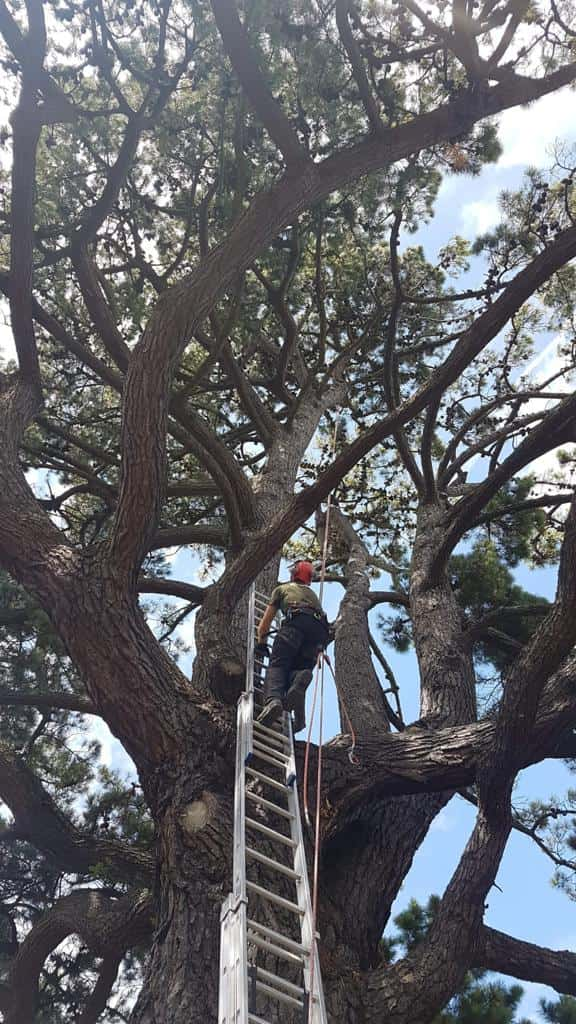A tree leaning unexpectedly can be a worrying sight for any property owner. While some trees naturally grow at a slight angle, a sudden change in position often signals an underlying problem that requires attention. Acting quickly can help prevent property damage, personal injury, or the complete loss of the tree. At LM Tree Surgery Petersfield in Petersfield, Hampshire, we’ve dealt with many cases of leaning trees and understand the importance of prompt assessment and professional intervention.
Understanding Why Trees Lean
Trees may begin to lean for a variety of reasons. Identifying the cause is the first step in determining how serious the situation is and what should be done next. Common reasons include:
- Root instability: High winds, saturated soil, or decay can weaken a tree’s root system, reducing its grip on the ground.
- Soil erosion: When the soil supporting one side of a tree is washed away, the foundation becomes unbalanced, leading to a lean.
- Uneven growth: Trees growing towards light sources may gradually lean over time, especially if competing with nearby vegetation.
- Structural weakness: Damage to the trunk, branches, or root base can compromise stability.
- Weather impact: Strong winds or heavy rainfall can shift the soil or put sudden stress on a tree’s structure.
While a mild lean in a healthy tree may not be cause for immediate alarm, a sudden or worsening lean often indicates that the tree is unsafe.
How to Assess the Situation Safely
If a tree on your property starts leaning, it’s important to assess it carefully but safely. Avoid standing directly underneath it or applying force to test its movement. Look for visible signs of distress such as:
- Uplifted or cracked soil around the base
- Exposed roots on one side of the trunk
- Splits or cracks in the trunk or large limbs
- Fresh soil displacement suggesting recent movement
- Tension or snapping sounds during windy conditions
If you notice any of these signs, it’s best to contact LM Tree Surgery Petersfield immediately for a professional inspection. Our trained arborists can evaluate the severity of the lean and determine whether the tree can be stabilised or if removal is necessary.
Immediate Steps to Take
When a tree starts leaning unexpectedly, your priority should be safety and prevention of further damage. Here’s what you can do while waiting for professional help:
- Keep people and pets away – Avoid the area beneath or near the leaning tree. If it’s near a structure or footpath, restrict access until the tree is assessed.
- Monitor changes – Take note of any worsening tilt, soil movement, or cracking noises. These can help professionals diagnose the issue.
- Avoid DIY fixes – Propping or tying the tree without expert guidance can make the situation worse or create new hazards.
- Call for expert help – Arborists have the equipment and expertise to assess structural stability safely and determine the right course of action.
At LM Tree Surgery Petersfield, our team uses advanced techniques to diagnose and manage leaning trees safely, whether through corrective pruning, cabling, or controlled removal if necessary.
Can a Leaning Tree Be Saved?
Not all leaning trees need to be removed. In many cases, particularly with young or slightly tilted trees, corrective measures can help restore balance. The success of these solutions depends on the cause and extent of the lean.
For Young Trees
If a newly planted or small tree begins to lean, gentle staking and corrective pruning can often encourage it to grow upright again. Adjusting soil support and monitoring root health are also effective measures.
For Mature Trees
Larger trees with a moderate lean might be stabilised using specialist bracing or cabling systems to redistribute weight and relieve stress on weakened areas. However, if the root system is severely compromised or decay is present, removal may be the safest option.
LM Tree Surgery Petersfield always aims to preserve trees wherever possible, offering expert advice tailored to the specific species and site conditions.
Preventing Trees from Leaning in the Future
Preventative care is key to avoiding sudden tree instability. Regular maintenance, such as pruning, soil care, and structural inspections, helps trees develop strong roots and balanced growth.
Best practices include:
- Pruning for even weight distribution to prevent lopsided canopies
- Maintaining healthy root zones by avoiding soil compaction and overwatering
- Inspecting trees after storms to detect early signs of movement
- Choosing suitable species for your soil type and site conditions
Our arborists at LM Tree Surgery Petersfield provide ongoing maintenance plans designed to keep your trees healthy, well-shaped, and secure throughout their lifespan.
Conclusion
A leaning tree can be more than just an aesthetic concern — it’s often a sign that the tree’s stability is compromised. Prompt action and expert assessment are essential to prevent potential damage and preserve tree health where possible. For professional assistance with leaning trees in Petersfield, LM Tree Surgery Petersfield offers reliable, expert care to assess, stabilise, or safely remove affected trees while maintaining the beauty and safety of your outdoor space.
Call us on: 01730 771 391
Click here to find out more about LM Tree Surgery Petersfield
Click here to complete our contact form and see how we can help with your trees needs.

